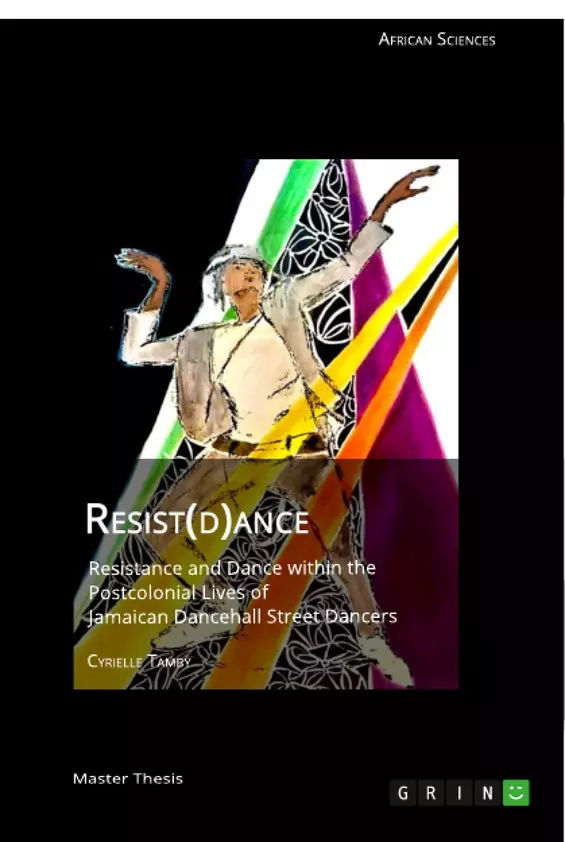While celebrated at first, Jamaica has struggled a lot with its independence and its implications for the people of Jamaica as well as different subcultures. In the aftermath of racial conflicts in the years following 1962, the genre of Dancehall surfaced and established itself in the 1980s. For the people living in the inner city of Kingston, which was largely separated from uptown, Dancehall was not just music, but represented a whole lifestyle.
While Dancehall has not lost any of its meaning since then, it certainly has changed and become important to many more people all around the world. But how exactly is this type of dance related to black identity, colonialism and the experience of racism? How did it manage to conquer the streets of Jamaica? And in what way is it represented in the digital world?
Cyrielle Tamby first explores the diasporic experience of blackness, and accounts for common grounds in being Black in Europe and in Jamaica. She scrutinizes the problem of silenced narratives in Jamaica, before moving on to the different aspects of dance as a form of resistance. Using the implication of her findings, the author then examines how knowledge can and has to be rethought through cultural production in diasporic making. Cyrielle Tamby claims in this book how the richness of popular cultures from the African diaspora that circulates across numerous podcast, literature, music and dance can challenge the lack of knowledge about the history of Black people. Her work is based on literary research as well as personal experience and provides the reader with some fascinating results.
Inhaltsverzeichnis (Table of Contents)
- INTRODUCTION
- THEORETICAL TOOLKIT AND SOME METHODOLOGICAL ISSUES
- The Diasporic experience of blackness.
- Recalling silenced narratives.
- Centering body politics by looking at Jamaican Dancehall as responsive to a postcolonial malaise in Jamaica.
- Tracing the notion of resistance in the Caribbean.
- Ethnography as a method to (de)construct knowledge
- DANCEHALL STREET PARTIES AS BLACK QUEER SPATIALITIES
- Street parties as cosmos of energies.
- Street parties as erotic and ritualistic architectures.
- Refashioning processes as a strategy of survival.
- Conquering the street: Tensions between national and local identity-makers
- Queering spatialities of black life.
- Epilogue
- MAPPING A HOME OUTSIDE OF HOME: DIASPORIC-MAKING, NEW-YORK AND THE CONSTANT STRUGGLE
- A home outside of home
- Mapping familiarity and the unknown in the diasporic-making.
- Generating an economy from diasporic-making.
- A gendered sense of diasporic-making.
- Struggling outside of home.
- Epilogue
- VERNACULAR LOVE: FOCUS ON TRANSNATIONAL AND TRANSACTIONAL LOVE RELATIONSHIPS
- Practices of street smartness.
- The Dancehall Hostel: Infrastructure of body-consuming.
- Epilogue
- DIGITAL TERRITORIALITY: INSTAGRAM AS A VISUAL ECONOMY OF BODIES AND WORD
- Archiving realities
- Conflating ephemeral and permanent temporalities.
- Visual economy of bodies
- Visual economy of words.
- Instagram as a vernacular poetry of resistance.
- Epilogue
- CODA
- Traveling across the territorialities of resistance.
- Repeated practices of resistance and their purpose
- Rethinking knowledge through cultural production in diasporic-making.
Zielsetzung und Themenschwerpunkte (Objectives and Key Themes)
This work aims to explore the experiences of Jamaican Dancehall street dancers, particularly those living in the diaspora, and to analyze the complex ways in which they negotiate and resist dominant power structures through their dance and cultural practices.
- The diasporic experience of blackness and its implications for identity formation and cultural expression.
- The role of Jamaican Dancehall in shaping and reflecting the social and political landscape of Jamaica and its diaspora.
- The interconnectedness of space, body politics, and resistance within the context of postcolonial Jamaica.
- The significance of vernacular cultures and digital platforms in facilitating and amplifying marginalized voices.
- The intersection of gender, sexuality, and race within the Dancehall community and its relationship to power dynamics.
Zusammenfassung der Kapitel (Chapter Summaries)
The first chapter establishes the framework for the study, introducing the author's personal journey and the theoretical lens through which she will analyze the Dancehall scene. Chapter 2 delves deeper into the methodological approach, examining the diasporic experience of blackness, silenced narratives, and the concept of resistance within the Caribbean context.
Chapter 3 explores the significance of Dancehall street parties as spaces for Black queer expression and resistance. The author examines the spatial dynamics of these events and how they operate as sites of both creative expression and social critique. Chapter 4 continues this exploration by focusing on the experiences of diasporic Dancehall dancers in New York, analyzing their struggles to create a sense of home outside of Jamaica.
Chapter 5 investigates the concept of "vernacular love" within the Dancehall community, focusing on transnational and transactional relationships. The author examines the complexities of these relationships and the ways in which they reflect the economic and social realities of the Dancehall scene. Chapter 6 explores the digital landscape of Dancehall through the lens of Instagram, analyzing how the platform functions as a visual economy of bodies and words. The chapter examines the ways in which dancers utilize Instagram to archive their realities, conflate temporalities, and assert their identities.
Schlüsselwörter (Keywords)
This work explores the concepts of resistance, diasporic experience, postcoloniality, Jamaican Dancehall, Black queer spatialities, body politics, vernacular culture, digital territoriality, Instagram, and transnational relationships.
- Quote paper
- Cyrielle Tamby (Author), 2019, Resist(d)ance, Munich, GRIN Verlag, https://www.grin.com/document/539232



